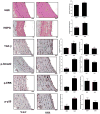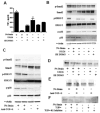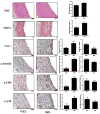Endothelial cells provide feedback control for vascular remodeling through a mechanosensitive autocrine TGF-beta signaling pathway
- PMID: 18583708
- PMCID: PMC2766078
- DOI: 10.1161/CIRCRESAHA.108.179465
Endothelial cells provide feedback control for vascular remodeling through a mechanosensitive autocrine TGF-beta signaling pathway
Abstract
Mechanical forces are potent modulators of the growth and hypertrophy of vascular cells. We examined the molecular mechanisms through which mechanical force and hypertension modulate endothelial cell regulation of vascular homeostasis. Exposure to mechanical strain increased the paracrine inhibition of vascular smooth muscle cells (VSMCs) by endothelial cells. Mechanical strain stimulated the production of perlecan and heparan sulfate glycosaminoglycans by endothelial cells. By inhibiting the expression of perlecan with an antisense vector we demonstrated that perlecan was essential to the strain-mediated effects on endothelial cell growth control. Mechanical regulation of perlecan expression in endothelial cells was governed by a mechanotransduction pathway requiring autocrine transforming growth factor beta (TGF-beta) signaling and intracellular signaling through the ERK pathway. Immunohistochemical staining of the aortae of spontaneously hypertensive rats demonstrated strong correlations between endothelial TGF-beta, phosphorylated signaling intermediates, and arterial thickening. Further, studies on ex vivo arteries exposed to varying levels of pressure demonstrated that ERK and TGF-beta signaling were required for pressure-induced upregulation of endothelial HSPG. Our findings suggest a novel feedback control mechanism in which net arterial remodeling to hemodynamic forces is controlled by a dynamic interplay between growth stimulatory signals from VSMCs and growth inhibitory signals from endothelial cells.
Conflict of interest statement
Figures






Similar articles
-
Contribution of extracellular signal-regulated kinase to angiotensin II-induced transforming growth factor-beta1 expression in vascular smooth muscle cells.Hypertension. 1999 Jul;34(1):126-31. doi: 10.1161/01.hyp.34.1.126. Hypertension. 1999. PMID: 10406835
-
Mechanisms of coronary angiogenesis in response to stretch: role of VEGF and TGF-beta.Am J Physiol Heart Circ Physiol. 2001 Feb;280(2):H909-17. doi: 10.1152/ajpheart.2001.280.2.H909. Am J Physiol Heart Circ Physiol. 2001. PMID: 11158993
-
PDGF-BB and TGF-{beta}1 on cross-talk between endothelial and smooth muscle cells in vascular remodeling induced by low shear stress.Proc Natl Acad Sci U S A. 2011 Feb 1;108(5):1908-13. doi: 10.1073/pnas.1019219108. Epub 2011 Jan 18. Proc Natl Acad Sci U S A. 2011. PMID: 21245329 Free PMC article.
-
Mechanosensitive properties in the endothelium and their roles in the regulation of endothelial function.J Cardiovasc Pharmacol. 2013 Jun;61(6):461-70. doi: 10.1097/FJC.0b013e31828c0933. J Cardiovasc Pharmacol. 2013. PMID: 23429585 Review.
-
Transforming growth factor-beta 1 and the development of vascular hypertrophy in hypertension.Blood Press Suppl. 1995;2:43-8. Blood Press Suppl. 1995. PMID: 7582073 Review.
Cited by
-
Single-cell sequencing technology in skin wound healing.Burns Trauma. 2024 Oct 23;12:tkae043. doi: 10.1093/burnst/tkae043. eCollection 2024. Burns Trauma. 2024. PMID: 39445224 Free PMC article. Review.
-
Endothelial-Vascular Smooth Muscle Cells Interactions in Atherosclerosis.Front Cardiovasc Med. 2018 Oct 23;5:151. doi: 10.3389/fcvm.2018.00151. eCollection 2018. Front Cardiovasc Med. 2018. PMID: 30406116 Free PMC article. Review.
-
Heparanase alters arterial structure, mechanics, and repair following endovascular stenting in mice.Circ Res. 2009 Feb 13;104(3):380-7. doi: 10.1161/CIRCRESAHA.108.180695. Epub 2008 Dec 18. Circ Res. 2009. PMID: 19096032 Free PMC article.
-
Specific Multiomic Profiling in Aortic Stenosis in Bicuspid Aortic Valve Disease.Biomedicines. 2024 Feb 6;12(2):380. doi: 10.3390/biomedicines12020380. Biomedicines. 2024. PMID: 38397982 Free PMC article.
-
Aberrant DNA Methylation Involved in Obese Women with Systemic Insulin Resistance.Open Life Sci. 2018 Jun 2;13:201-207. doi: 10.1515/biol-2018-0024. eCollection 2018 Jan. Open Life Sci. 2018. PMID: 33817084 Free PMC article.
References
-
- Libby P, Aikawa M, Jain MK. Vascular endothelium and atherosclerosis. Handb Exp Pharmacol. 2006;176:285–306. - PubMed
-
- Li YS, Haga JH, Chien S. Molecular basis of the effects of shear stress on vascular endothelial cells. J Biomech. 2005;38:1949–1971. - PubMed
-
- Harrison DG, Widder J, Grumbach I, Chen W, Weber M, Searles C. Endothelial mechanotransduction, nitric oxide and vascular inflammation. J Intern Med. 2006;259:351–363. - PubMed
Publication types
MeSH terms
Substances
Grants and funding
LinkOut - more resources
Full Text Sources
Miscellaneous

